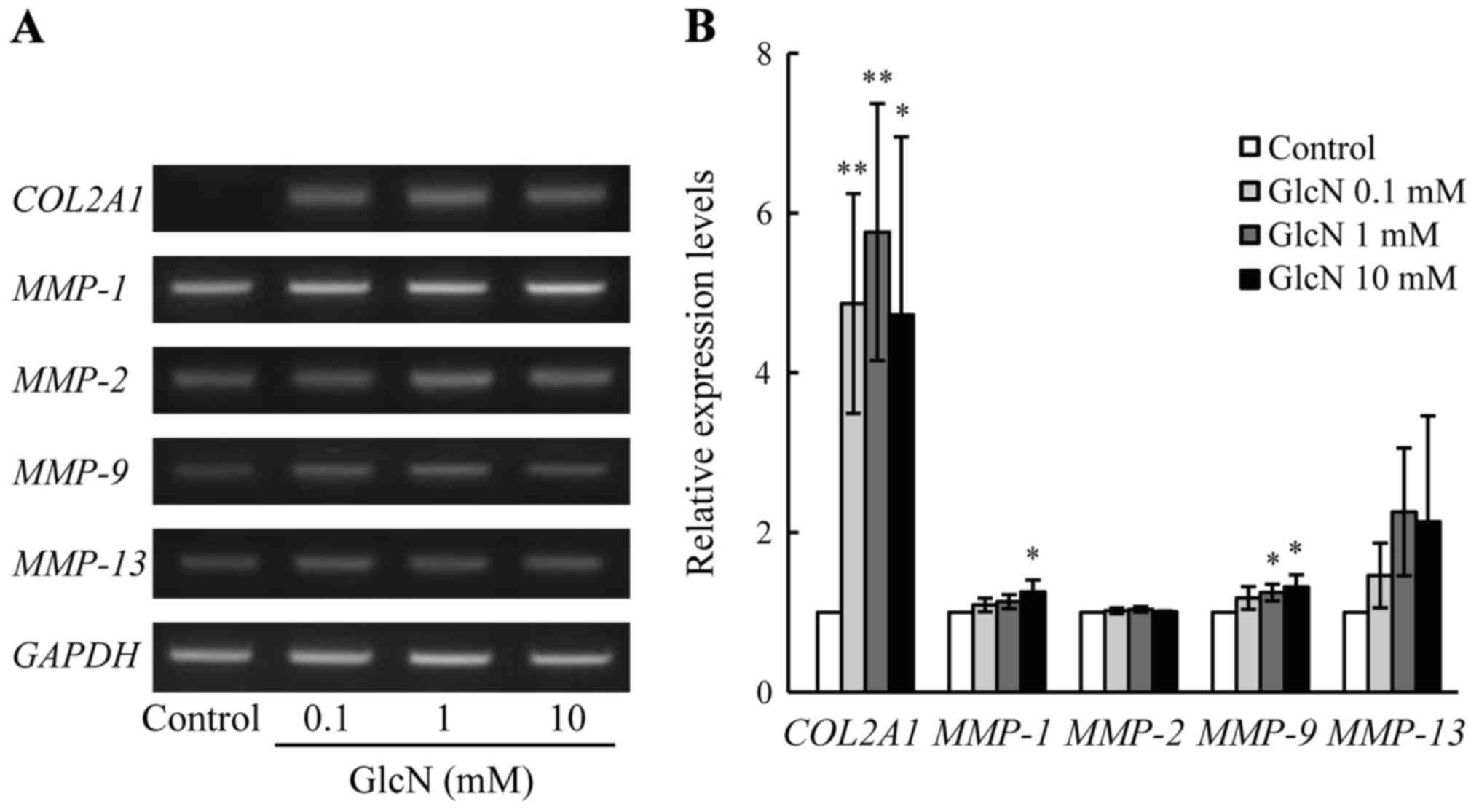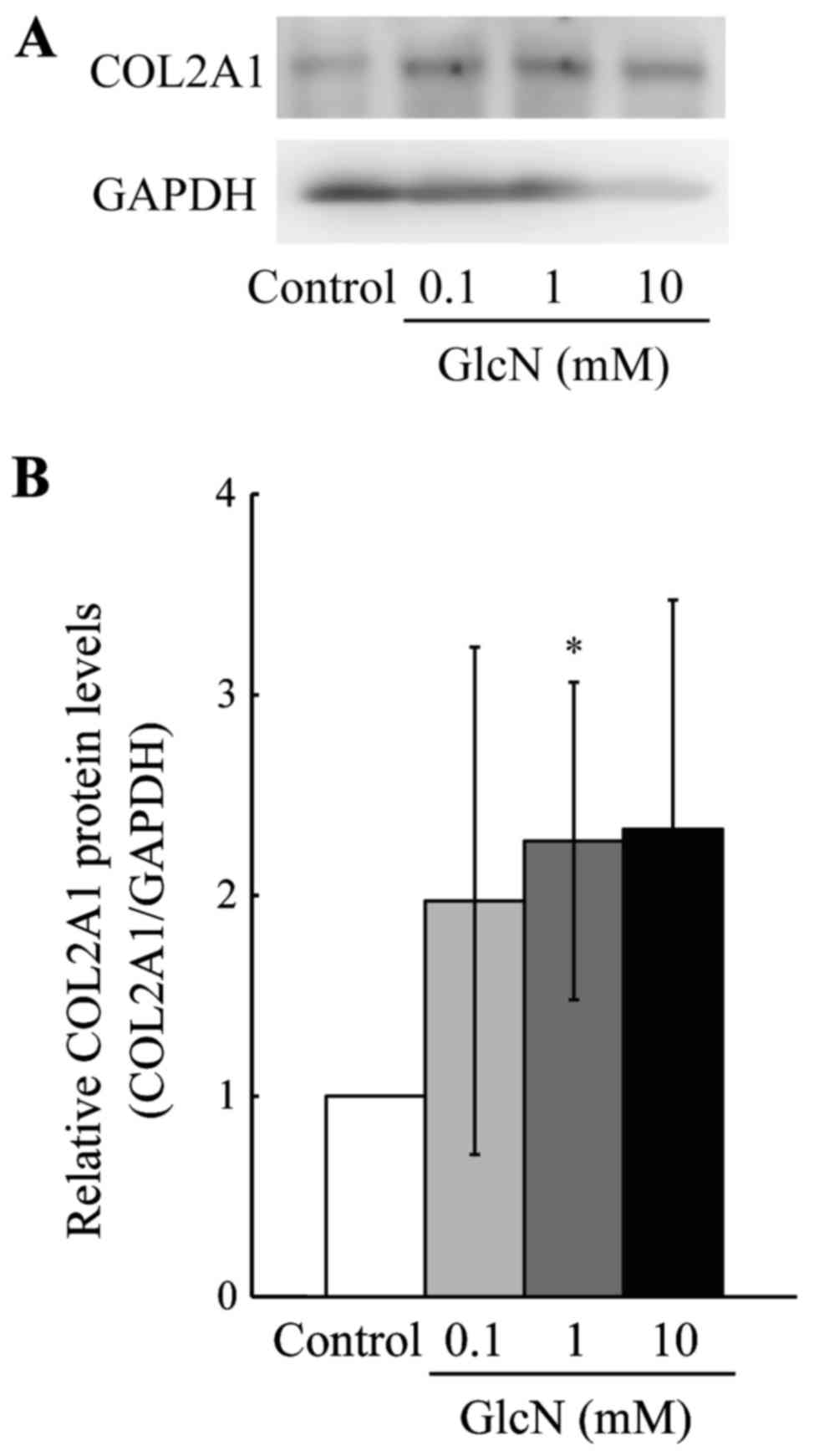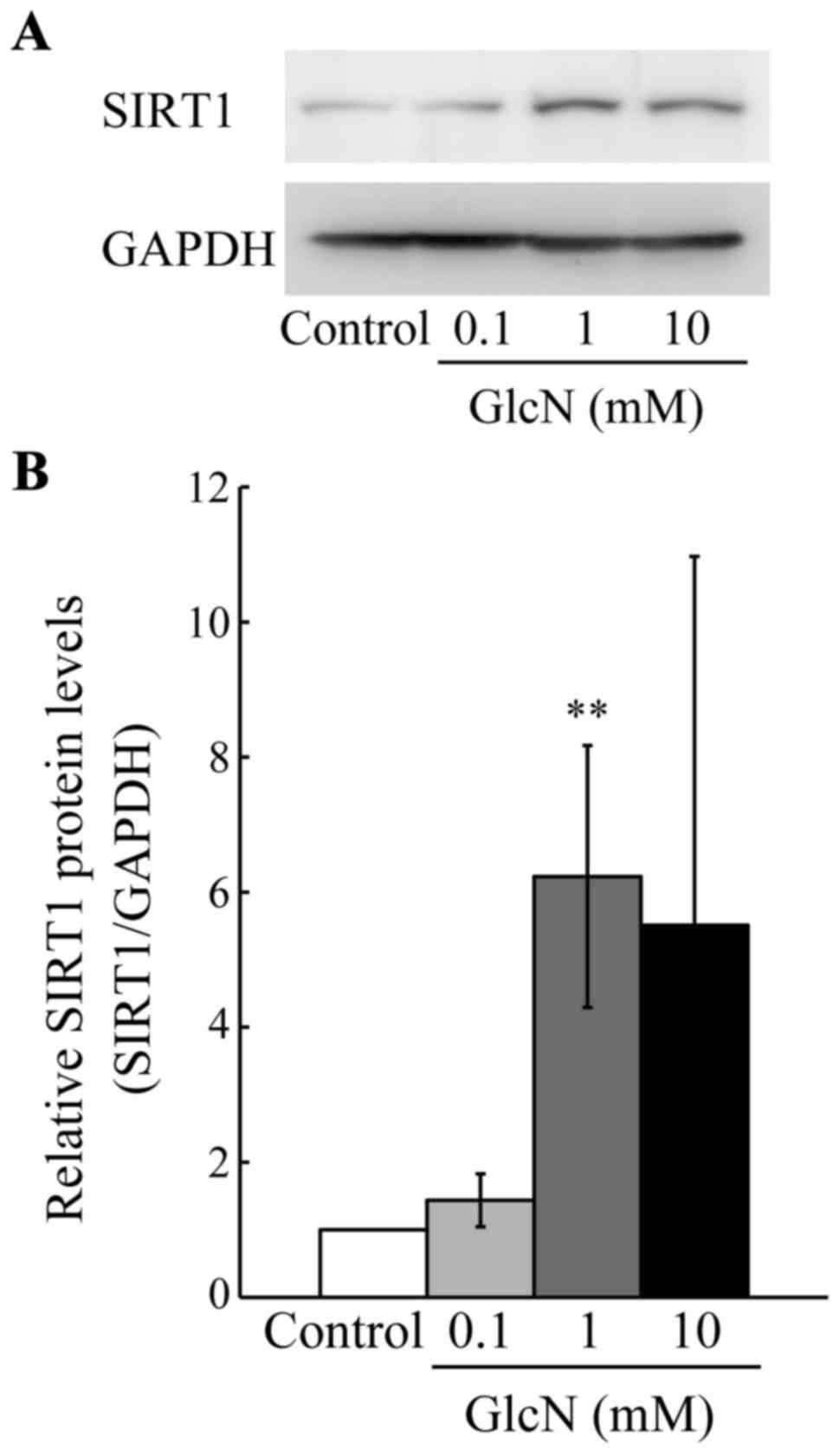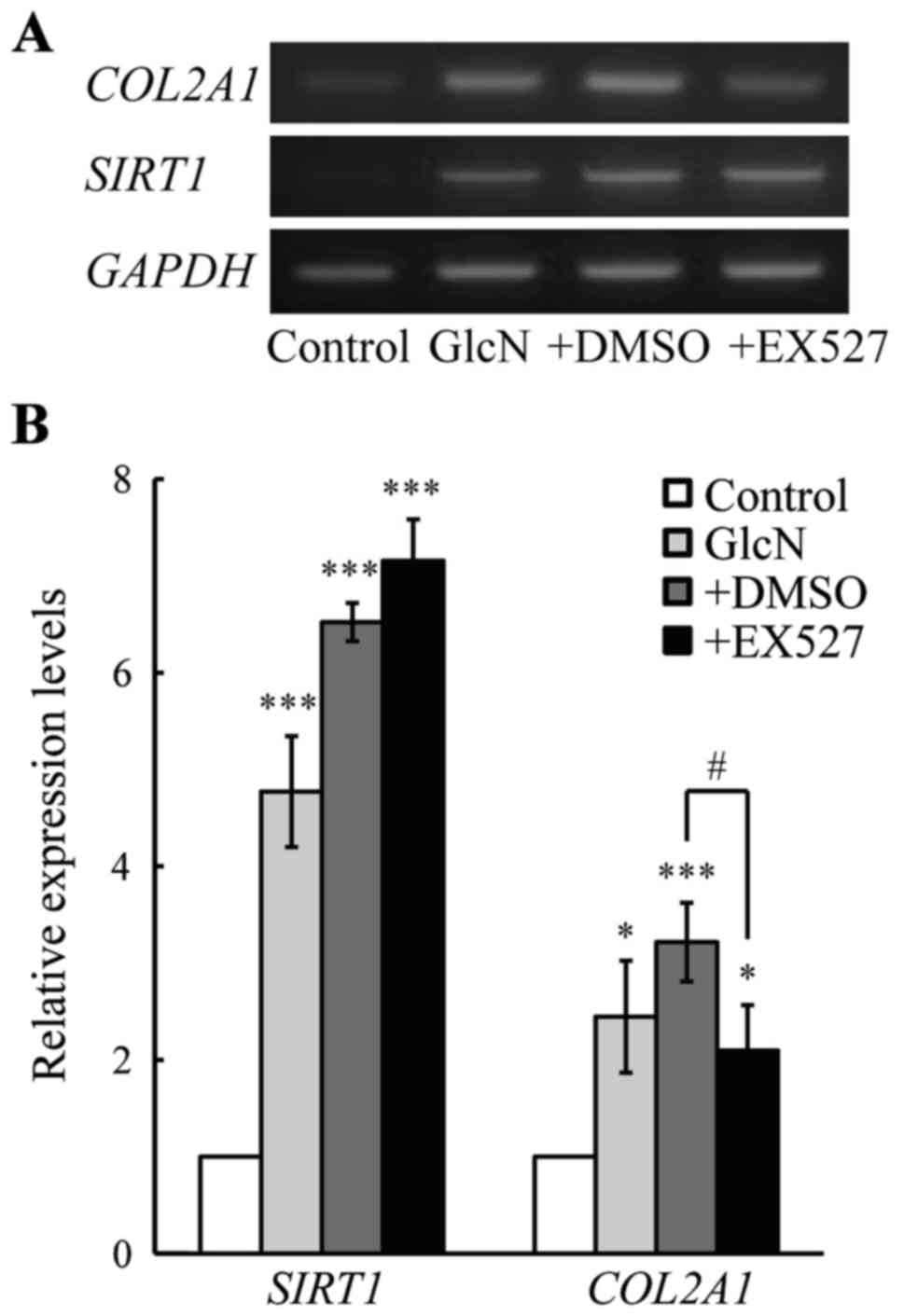|
1
|
Hunter DJ and Felson DT: Osteoarthritis.
BMJ. 332:639–642. 2006. View Article : Google Scholar : PubMed/NCBI
|
|
2
|
Gabriel SE, Crowson CS, Campion ME and
O'Fallon WM: Direct medical costs unique to people with arthritis.
J Rheumatol. 24:719–725. 1997.PubMed/NCBI
|
|
3
|
March LM and Bachmeier CJ: Economics of
osteoarthritis: a global perspective. Baillieres Clin Rheumatol.
11:817–834. 1997. View Article : Google Scholar
|
|
4
|
Loeser RF: Age-related changes in the
musculoskeletal system and the development of osteoarthritis. Clin
Geriatr Med. 26:371–386. 2010. View Article : Google Scholar : PubMed/NCBI
|
|
5
|
Goldring MB: The role of cytokines as
inflammatory mediators in osteoarthritis: lessons from animal
models. Connect Tissue Res. 40:1–11. 1999. View Article : Google Scholar
|
|
6
|
Crolle G and D'Este E: Glucosamine
sulphate for the management of arthrosis: a controlled clinical
investigation. Curr Med Res Opin. 7:104–109. 1980. View Article : Google Scholar : PubMed/NCBI
|
|
7
|
Drovanti A, Bignamini AA and Rovati AL:
Therapeutic activity of oral glucosamine sulfate in osteoarthrosis:
a placebo-controlled double-blind investigation. Clin Ther.
3:260–272. 1980.PubMed/NCBI
|
|
8
|
Tapadinhas MJ, Rivera IC and Bignamini AA:
Oral glucosamine sulphate in the management of arthrosis: report on
a multi-centre open investigation in Portugal. Pharmatherapeutica.
3:157–168. 1982.PubMed/NCBI
|
|
9
|
Lopes Vaz A: Double-blind clinical
evaluation of the relative efficacy of ibuprofen and glucosamine
sulphate in the management of osteoarthrosis of the knee in
out-patients. Curr Med Res Opin. 8:145–149. 1982. View Article : Google Scholar : PubMed/NCBI
|
|
10
|
McAlindon TE, LaValley MP, Gulin JP and
Felson DT: Glucosamine and chondroitin for treatment of
osteoarthritis: a systematic quality assessment and meta-analysis.
JAMA. 283:1469–1475. 2000. View Article : Google Scholar : PubMed/NCBI
|
|
11
|
Reginster JY, Deroisy R, Rovati LC, Lee
RL, Lejeune E, Bruyere O, Giacovelli G, Henrotin Y, Dacre JE and
Gossett C: Long-term effects of glucosamine sulphate on
osteoarthritis progression: a randomised, placebo-controlled
clinical trial. Lancet. 357:251–256. 2001. View Article : Google Scholar : PubMed/NCBI
|
|
12
|
Pavelká K, Gatterová J, Olejarová M,
Machacek S, Giacovelli G and Rovati LC: Glucosamine sulfate use and
delay of progression of knee osteoarthritis: a 3-year, randomized,
placebo-controlled, double-blind study. Arch Intern Med.
162:2113–2123. 2002. View Article : Google Scholar : PubMed/NCBI
|
|
13
|
Igarashi M, Kaga I, Takamori Y, Sakamoto
K, Miyazawa K and Nagaoka I: Effects of glucosamine derivatives and
uronic acids on the production of glycosaminoglycans by human
synovial cells and chondrocytes. Int J Mol Med. 27:821–827.
2011.PubMed/NCBI
|
|
14
|
Loeser RF: Molecular mechanisms of
cartilage destruction: mechanics, inflammatory mediators, and aging
collide. Arthritis Rheum. 54:1357–1360. 2006. View Article : Google Scholar : PubMed/NCBI
|
|
15
|
Abramson SB, Attur M and Yazici Y:
Prospects for disease modification in osteoarthritis. Nat Clin
Pract Rheumatol. 2:304–312. 2006. View Article : Google Scholar : PubMed/NCBI
|
|
16
|
Goldring MB and Goldring SR:
Osteoarthritis. J Cell Physiol. 213:626–634. 2007. View Article : Google Scholar : PubMed/NCBI
|
|
17
|
Attur M, Krasnokutsky-Samuels S, Samuels J
and Abramson SB: Prognostic biomarkers in osteoarthritis. Curr Opin
Rheumatol. 25:136–144. 2013. View Article : Google Scholar :
|
|
18
|
Li Y, Tsun A, Gao Z, Han Z, Gao Y, Li Z,
Lin F, Wang Y, Wei G, Yao Z, et al: 60-kDa Tat-interactive protein
(TIP60) positively regulates Th-inducing POK (ThPOK)-mediated
repression of eomesodermin in human CD4+ T cells. J Biol
Chem. 288:15537–15546. 2013. View Article : Google Scholar : PubMed/NCBI
|
|
19
|
Hattori T, Kubota S, Yutani Y, Fujisawa T,
Nakanishi T, Takahashi K and Takigawa M: Change in cellular
localization of a rheumatoid arthritis-related antigen (RA-A47)
with downregulation upon stimulation by inflammatory cytokines in
chondrocytes. J Cell Physiol. 186:268–281. 2001. View Article : Google Scholar : PubMed/NCBI
|
|
20
|
Neumann C, Yu A, Welge-Lüssen U,
Lütjen-Drecoll E and Birke M: The effect of TGF-beta2 on elastin,
type VI collagen, and components of the proteolytic degradation
system in human optic nerve astrocytes. Invest Ophthalmol Vis Sci.
49:1464–1472. 2008. View Article : Google Scholar : PubMed/NCBI
|
|
21
|
Kim SO and Kim MR: [6]-Gingerol prevents
disassembly of cell junctions and activities of MMPs in invasive
human pancreas cancer cells through ERK/NF-κB/Snail signal
transduction pathway. Evid Based Complement Alternat Med.
2013:7618522013. View Article : Google Scholar
|
|
22
|
Liacini A, Sylvester J, Li WQ, Huang W,
Dehnade F, Ahmad M and Zafarullah M: Induction of matrix
metalloproteinase-13 gene expression by TNF-alpha is mediated by
MAP kinases, AP-1, and NF-kappaB transcription factors in articular
chondrocytes. Exp Cell Res. 288:208–217. 2003. View Article : Google Scholar : PubMed/NCBI
|
|
23
|
Shah ZH, Ahmed SU, Ford JR, Allison SJ,
Knight JRP and Milner J: A deacetylase-deficient SIRT1 variant
opposes full-length SIRT1 in regulating tumor suppressor p53 and
governs expression of cancer-related genes. Mol Cell Biol.
32:704–716. 2012. View Article : Google Scholar :
|
|
24
|
Ji S, Doucette JR and Nazarali AJ: Sirt2
is a novel in vivo downstream target of Nkx2.2 and enhances
oligodendroglial cell differentiation. J Mol Cell Biol. 3:351–359.
2011. View Article : Google Scholar : PubMed/NCBI
|
|
25
|
Grubisha O, Rafty LA, Takanishi CL, Xu X,
Tong L, Perraud AL, Scharenberg AM and Denu JM: Metabolite of SIR2
reaction modulates TRPM2 ion channel. J Biol Chem. 281:14057–14065.
2006. View Article : Google Scholar : PubMed/NCBI
|
|
26
|
Song R, Xu W, Chen Y, Li Z, Zeng Y and Fu
Y: The expression of sirtuins 1 and 4 in peripheral blood
leukocytes from patients with type 2 diabetes. Eur J Histochem.
55:e102011. View Article : Google Scholar : PubMed/NCBI
|
|
27
|
Orecchia A, Scarponi C, Di Felice F,
Cesarini E, Avitabile S, Mai A, Mauro ML, Sirri V, Zambruno G,
Albanesi C, et al: Sirtinol treatment reduces inflammation in human
dermal microvascular endothelial cells. PLoS One. 6:e243072011.
View Article : Google Scholar : PubMed/NCBI
|
|
28
|
Kanfi Y, Shalman R, Peshti V, Pilosof SN,
Gozlan YM, Pearson KJ, Lerrer B, Moazed D, Marine JC, de Cabo R, et
al: Regulation of SIRT6 protein levels by nutrient availability.
FEBS Lett. 582:543–548. 2008. View Article : Google Scholar : PubMed/NCBI
|
|
29
|
Dvir-Ginzberg M, Gagarina V, Lee EJ and
Hall DJ: Regulation of cartilage-specific gene expression in human
chondrocytes by SirT1 and nicotinamide phosphoribosyltransferase. J
Biol Chem. 283:36300–36310. 2008. View Article : Google Scholar : PubMed/NCBI
|
|
30
|
Gray SG and Ekström TJ: The human histone
deacetylase family. Exp Cell Res. 262:75–83. 2001. View Article : Google Scholar : PubMed/NCBI
|
|
31
|
Gertz M, Fischer F, Nguyen GTT,
Lakshminarasimhan M, Schutkowski M, Weyand M and Steegborn C:
Ex-527 inhibits sirtuins by exploiting their unique
NAD+-dependent deacetylation mechanism. Proc Natl Acad
Sci USA. 110:E2772–E2781. 2013. View Article : Google Scholar
|
|
32
|
Nagaoka I, Igarashi M and Sakamoto K:
Biological activities of glucosamine and its related substances.
Adv Food Nutr Res. 65:337–352. 2012. View Article : Google Scholar : PubMed/NCBI
|
|
33
|
Bhosale AM and Richardson JB: Articular
cartilage: structure, injuries and review of management. Br Med
Bull. 87:77–95. 2008. View Article : Google Scholar : PubMed/NCBI
|
|
34
|
Eyre DR: Collagens and cartilage matrix
homeostasis. Clin Orthop Relat Res. 427(Suppl): S118–S122. 2004.
View Article : Google Scholar
|
|
35
|
Eyre DR, Weis MA and Wu JJ: Articular
cartilage collagen: an irreplaceable framework? Eur Cell Mater.
12:57–63. 2006. View Article : Google Scholar : PubMed/NCBI
|
|
36
|
Block JA, Oegema TR, Sandy JD and Plaas A:
The effects of oral glucosamine on joint health: is a change in
research approach needed? Osteoarthritis Cartilage. 18:5–11. 2010.
View Article : Google Scholar
|
|
37
|
Varghese S, Theprungsirikul P, Sahani S,
Hwang N, Yarema KJ and Elisseeff JH: Glucosamine modulates
chondrocyte proliferation, matrix synthesis, and gene expression.
Osteoarthritis Cartilage. 15:59–68. 2007. View Article : Google Scholar
|
|
38
|
Derfoul A, Miyoshi AD, Freeman DE and Tuan
RS: Glucosamine promotes chondrogenic phenotype in both
chondrocytes and mesenchymal stem cells and inhibits MMP-13
expression and matrix degradation. Osteoarthritis Cartilage.
15:646–655. 2007. View Article : Google Scholar : PubMed/NCBI
|
|
39
|
Stoppoloni D, Politi L, Leopizzi M,
Gaetani S, Guazzo R, Basciani S, Moreschini O, De Santi M,
Scandurra R and Scotto d'Abusco A: Effect of glucosamine and its
peptidyl-derivative on the production of extracellular matrix
components by human primary chondrocytes. Osteoarthritis Cartilage.
23:103–113. 2015. View Article : Google Scholar
|
|
40
|
Gabay O, Oppenhiemer H, Meir H, Zaal K,
Sanchez C and Dvir-Ginzberg M: Increased apoptotic chondrocytes in
articular cartilage from adult heterozygous SirT1 mice. Ann Rheum
Dis. 71:613–616. 2012. View Article : Google Scholar : PubMed/NCBI
|
|
41
|
Matsuzaki T, Matsushita T, Takayama K,
Matsumoto T, Nishida K, Kuroda R and Kurosaka M: Disruption of
Sirt1 in chondrocytes causes accelerated progression of
osteoarthritis under mechanical stress and during ageing in mice.
Ann Rheum Dis. 73:1397–1404. 2014. View Article : Google Scholar
|
|
42
|
Gabay O, Sanchez C, Dvir-Ginzberg M,
Gagarina V, Zaal KJ, Song Y, He XH and McBurney MW: Sirtuin 1
enzymatic activity is required for cartilage homeostasis in vivo in
a mouse model. Arthritis Rheum. 65:159–166. 2013. View Article : Google Scholar
|
|
43
|
Hong EH, Lee SJ, Kim JS, Lee KH, Um HD,
Kim JH, Kim SJ, Kim JI and Hwang SG: Ionizing radiation induces
cellular senescence of articular chondrocytes via negative
regulation of SIRT1 by p38 kinase. J Biol Chem. 285:1283–1295.
2010. View Article : Google Scholar :
|
|
44
|
Takayama K, Ishida K, Matsushita T, Fujita
N, Hayashi S, Sasaki K, Tei K, Kubo S, Matsumoto T, Fujioka H, et
al: SIRT1 regulation of apoptosis of human chondrocytes. Arthritis
Rheum. 60:2731–2740. 2009. View Article : Google Scholar : PubMed/NCBI
|
|
45
|
Gagarina V, Gabay O, Dvir-Ginzberg M, Lee
EJ, Brady JK, Quon MJ and Hall DJ: SirT1 enhances survival of human
osteoarthritic chondrocytes by repressing protein tyrosine
phosphatase 1B and activating the insulin-like growth factor
receptor pathway. Arthritis Rheum. 62:1383–1392. 2010. View Article : Google Scholar : PubMed/NCBI
|
|
46
|
Fujita N, Matsushita T, Ishida K, Kubo S,
Matsumoto T, Takayama K, Kurosaka M and Kuroda R: Potential
involvement of SIRT1 in the pathogenesis of osteoarthritis through
the modulation of chondrocyte gene expressions. J Orthop Res.
29:511–515. 2011. View Article : Google Scholar : PubMed/NCBI
|
|
47
|
Moon MH, Jeong JK, Lee YJ, Seol JW,
Jackson CJ and Park SY: SIRT1, a class III histone deacetylase,
regulates TNF-α-induced inflammation in human chondrocytes.
Osteoarthritis Cartilage. 21:470–480. 2013. View Article : Google Scholar
|
|
48
|
Matsushita T, Sasaki H, Takayama K, Ishida
K, Matsumoto T, Kubo S, Matsuzaki T, Nishida K, Kurosaka M and
Kuroda R: The overexpression of SIRT1 inhibited osteoarthritic gene
expression changes induced by interleukin-1β in human chondrocytes.
J Orthop Res. 31:531–537. 2013. View Article : Google Scholar
|
|
49
|
Wells L, Whelan SA and Hart GW: O-GlcNAc:
a regulatory post-translational modification. Biochem Biophys Res
Commun. 302:435–441. 2003. View Article : Google Scholar : PubMed/NCBI
|
|
50
|
Love DC and Hanover JA: The hexosamine
signaling pathway: deciphering the 'O-GlcNAc code'. Sci STKE.
2005:re132005.
|
|
51
|
Chou TY, Dang CV and Hart GW:
Glycosylation of the c-Myc transactivation domain. Proc Natl Acad
Sci USA. 92:4417–4421. 1995. View Article : Google Scholar : PubMed/NCBI
|
|
52
|
Han I and Kudlow JE: Reduced O
glycosylation of Sp1 is associated with increased proteasome
susceptibility. Mol Cell Biol. 17:2550–2558. 1997. View Article : Google Scholar : PubMed/NCBI
|
|
53
|
Jiang MS and Hart GW: A subpopulation of
estrogen receptors are modified by O-linked N-acetylglucosamine. J
Biol Chem. 272:2421–2428. 1997. View Article : Google Scholar : PubMed/NCBI
|
|
54
|
Yang WH, Kim JE, Nam HW, Ju JW, Kim HS,
Kim YS and Cho JW: Modification of p53 with O-linked
N-acetylglucosamine regulates p53 activity and stability. Nat Cell
Biol. 8:1074–1083. 2006. View Article : Google Scholar : PubMed/NCBI
|
|
55
|
Fujiki R, Hashiba W, Sekine H, Yokoyama A,
Chikanishi T, Ito S, Imai Y, Kim J, He HH, Igarashi K, et al:
GlcNAcylation of histone H2B facilitates its monoubiquitination.
Nature. 480:557–560. 2011.PubMed/NCBI
|
|
56
|
Ju Y, Hua J, Sakamoto K, Ogawa H and
Nagaoka I: Glucosamine, a naturally occurring amino monosaccharide
modulates LL-37-induced endothelial cell activation. Int J Mol Med.
22:657–662. 2008.PubMed/NCBI
|
|
57
|
Ju Y, Hua J, Sakamoto K, Ogawa H and
Nagaoka I: Modulation of TNF-alpha-induced endothelial cell
activation by glucosamine, a naturally occurring amino
monosaccharide. Int J Mol Med. 22:809–815. 2008.PubMed/NCBI
|
|
58
|
Someya A, Sakamoto K and Nagaoka I:
Glucosamine induces the O-N-acetylglucosamine modification of
transcription factor Sp1. Glucosamine Res. 9:48–52. 2013.
|















